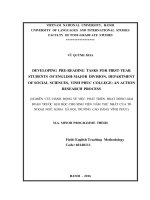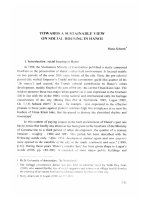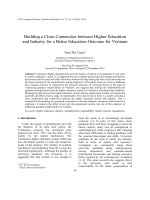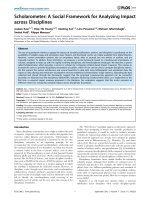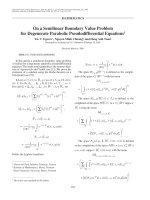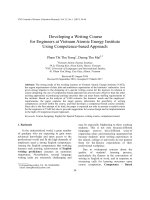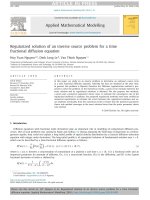DSpace at VNU: Designing a Competency-based English Oral Communication Course for Vietnamese Undergraduate Business Administration Students
Bạn đang xem bản rút gọn của tài liệu. Xem và tải ngay bản đầy đủ của tài liệu tại đây (373.35 KB, 12 trang )
VNU Journal of Science: Foreign Studies, Vol. 32, No. 4 (2016) 74-85
Designing a Competency-based English Oral
Communication Course for Vietnamese Undergraduate
Business Administration Students
Nguyen Thi Minh Tram*
Honors Program, Faculty of English Language Teacher Education, VNU University of Languages and
International Studies, Pham Van Dong, Cau Giay, Hanoi, Vietnam
Received 27 August 2016
Revised 04 November 2016; Accepted 21 November 2016
Abstract: Vietnam’s accession into international organizations especially ASEAN Economic
Community emphasizes the necessity of an appropriate course of English oral communication
(EOC) to prepare the business administration (BA) undergraduates with necessary knowledge,
skills and abilities to meet the real workplace requirements. The study, therefore, aims at designing
an appropriate competency-based EOC course for BA undergraduates. Both quantitative and
qualitative data were collected in a mixed methods study. In order to achieve the aims of the study,
the course has been designed from the results of a thorough needs analysis starting from interviews
with all the stakeholders and then a survey questionnaire with BA undergraduates in a university in
Vietnam. Then it was verified with a survey questionnaire with the teachers, piloted with a group
of BA undergraduates with observation, questionnaires and reflective journals before being
implemented and evaluated with questionnaires, test scores, reflective journals and focus group
interview during and after the course, and a questionnaire survey after the internship. The results
from both quantitative and qualitative data revealed the effectiveness of the course in improving
BA undergraduates’ EOC competencies.
Keywords: Course design, English oral communication, business administration, competency,
socio-cultural theory.
1. Introduction
business deals than ever before. These
opportunities have strengthened the motivation
and also set out the urgent requirements for
Vietnamese labor force in general and business
administration (BA) graduates in particular to
acquire a good command of English to interact
in real-life workplace. However, the issue of
discrepancies between university English
language curriculum and English language
requirements for jobs have been mentioned in
many studies [1-3]. In most of universities in
The accession into the World Trade
Organization since 2006, Trans-Pacific
Partnership and Asian Economic Community
since 2015 assisting Vietnam in integrating
further into the global trading system has
brought up more potential international
_______
Tel.: 84-915371945
Email:
74
N.T.M. Tram / VNU Journal of Science: Foreign Studies, Vol. 32, No. 4 (2016) 74-85
Vietnam, BA undergraduates’ English for
specific purposes (ESP) courses mainly focus
on reading or translating ESP materials while
“ESP should be redirected away from foreign
language education and towards training in
communication for professional purposes in
which the foreign language arises” [4]. This has
resulted in a call for additional English courses
designed for their occupational focus on oral
communication. [4] also state that “the content
of ESP course should be based on evidence, not
teacher intuition” so the rationale for choosing
to investigate this issue lies in the importance of
thorough NA for designing an ESP course and
also the necessity of teaching and learning of
English for real business communication.
Hence, the research questions that the present
study seeks to answer are:
RQ1: What are the components of a
competency-based English oral communication
course designed to prepare business
administration
undergraduates
for
the
workplace?
RQ2: To what extent is the designed course
effective
in
developing
English
oral
communication competencies for business
administration undergraduates?
2. Competency-based approach
Competency-based
education
(CBE)
referred to an educational movement that
advocated defining educational goals in terms
of precise measurable description of the
knowledge, skills, and behaviours students
should acquire at the end of a course of study
[5, 6] asserts that competencies as “a
description of the essential skills, knowledge
and attitude required for effective performance
of particular tasks and activities” (p.159). [7]
also shares this idea when defining
competencies as “sum of knowledge, skills and
characteristics that allow a person to perform
action”. Thus, the structure of a competency is
formed by experience that includes knowledge,
skills and attitudes which determine an
75
individual’s readiness for activity. The
competency-based approach that has been
widely used as the basis for the design of workrelated and survival-oriented language teaching
programs for adults [8] can be introduced in
response to growing concerns that students
were not being taught what they required after
they left school. With the focus on the expected
outcomes as a product-based methodology, this
approach matches with purpose of the course
which is BA graduates enabled with adequate
EOC competencies to be ready for the
workplace.
3. Socio-cultural learning theory
Socio-cultural views of learning built upon
constructivist approaches are often linked
together in the psychological and pedagogic
literature, and they include the premise that
second language teaching and learning take
place within the social interactions of learners
and more capable others and seek to understand
the cultural and historical influences on learning
[9, 10]. It is widely believed that SCT of mind
and the concept of ZPD form the basis of the
notion of scaffolding [11, 12]. The three
distinctive propositions of SCT which are
selected for the design of the teaching and
learning plan in present study are: 1) Roles of
social interactions with teachers and peers
through
others-regulation
after
objectregulation, and finally self- regulation are
pivotal in the learners’ learning process; 2) ZPD
can be achieved with understanding of what
learners have known and how to scaffold their
learning further; 3) the socio-cultural context
needs to be considered for situated learning.
4. Research methodology
The present study is a mixed methods
design that collects both quantitative and
qualitative data. The chosen mixed methods
design was an exploratory and a convergent
design. There were two main phases in the
76
N.T.M. Tram / VNU Journal of Science: Foreign Studies, Vol. 32, No. 4 (2016) 74-85
present study: Establishing course components,
and implementing and evaluating course to
answer the first and second research question
respectively.
4.1. Phase 1: Establishing course components
The first phase of the present study consists
of three main stages namely NA, course
verification, and pilot study.
4.1.1. Needs analysis
The needs analysis in the present study
consisted of two main steps. First, semistructured interviews were conducted with 35
participants including 12 teachers, 8 BA
graduates 15 employers from October 2014 to
December 2014. Specifically, 12 full-time
experienced teachers of BA undergraduates (4
content teachers and 8 language ones) were
selected from 4 universities (A, B, C and D)
which have at least 2 cohorts of BA graduates.
The selected BA graduates and employers
worked in the field of commerce, travel, and
manufacturing where employees had frequent
chances of using EOC.
Second, a survey questionnaire designed
based on the findings of the interviews.
Specifically, for the item generation, the
construction of the questionnaire was developed
on the basis of the results regarding the key
EOC competencies, common difficulties and
suggestions for the course components from the
in-depth semi-structured interviews. After being
designed, the questionnaire was piloted with a
group of 30 BA undergraduates from university
A to see whether the questions were
understandable and clear. Then, regarding item
reduction after the pilot, the items related to
gender and speaking courses they completed
were reduced since this information was not
necessary for the research results. Besides,
some minor adjustments regarding the format
were done for the convenience of rating. Next,
the questionnaire was conducted with 227 BA
undergraduates from the first to third year at
university A to investigate their needs of an
EOC course in the middle of March 2015.
4.1.2. Course verification
Eight language teachers who had involved
in the semi-structured interviews in NA were
invited again to evaluate the design of the
proposed course in a survey questionnaire
administered in face-to face meetings from May
2015 to June 2015. The questionnaire included
a set of the criteria that was adapted from [13]
to evaluate the design of the proposed EOC
course components with some appropriate
adjustments.
4.1.3. Pilot study
The course was piloted during the first two
weeks of August 2015 with 12 participants
having similar characteristics with those in the
main study. After each lesson, the participants
were required to write a journal, complete
questionnaires at the end of each lesson and the
pilot study. Finally, they took part in an oral
test. The Dean of Faculty of Foreign Languages
at university A was invited to observe how the
class went each week while another
experienced teacher from the university was
invited to be a co-examiner with the researcher
in the oral test.
4.2. Phase 2: Implementing and evaluating
the designed EOC course
The second phase of the present study aims
at answering the second research question. The
proposed course was implemented with a group
of 32 BA fourth-year undergraduates of
university A during 15 weeks from September
2015 to December 2015. Different data
collection instruments chosen for the present
study were tests, questionnaires, reflective
journals, and focus group interview. All of
those instruments were designed with
consultation by two experts in course design
field and two practitioner instructors, except for
the the test and unit self-assessments, and endof-course questionnaire which were adapted
from [13].
The participants sat for 3 oral tests: pre-test,
midterm test and post-test, which were designed
following the guidelines of test specifications,
N.T.M. Tram / VNU Journal of Science: Foreign Studies, Vol. 32, No. 4 (2016) 74-85
and the description of test task characteristics
and specific purpose language ability based on
the framework of Language for Specific
Purpose (LSP) testing theory by [14]. Besides,
the tests were also designed in line with the
course learning outcomes and the descriptive
level of pre-B1 according to NFRSFLC [15] and
with the expert consultation. Then, the oral test
was piloted and adjusted appropriately. The test
consisted of three main parts for a pair of
undergraduates. The first part was a
conversation between the interlocutor and each
candidate in topics such as giving personal
information,
talking
about
present
circumstances, past experiences and future
plans. The contents of the second and third
parts were designed based on the learning
outcomes of the course. Specifically, the former
part was a mini-talk between two candidates on
a business-related topic in socializing such as
greeting visitors, making a small talk,
developing a conversation, and exchanging
information about company products and
services while the latter was on making a phone
call of taking and leaving messages, selling and
buying products or services, making or
changing an appointment.
At the end of each unit, they had to finish a
self-assessment and a reflective journal to keep
fresh idea. Self-assessments after each unit
were mainly about assessment on some major
aspects of a lesson such as lesson content,
materials, activities, speed, teaching methods
and
finally
self-assessment
on
their
achievement of lesson objectives. Reflective
journal was divided into three main parts (i.e.
classroom environment, awareness of your
EOC competencies and affective factors and
motivation) with prompts to guide the
participants with more focus (e.g. In as detailed
a manner as you can, tell me about to what
extent did the classroom environment today
support you and your peers to learn?).
At the end of the course, all the participants
completed an end-of-course questionnaire
which was adapted from [13] with some
appropriate adjustments. Then, they participated
77
in focus-group interviews to study their
opinions towards the overall developed course
in terms of their satisfaction, its usefulness and
practicality as well as to explore their
suggestions for improving the course. After the
internship in May 2016, 13 BA undergraduates
who used EOC during this time and their
internship
supervisors
completed
postinternship survey questionnaires, which were
mainly about their confidence in using two
general EOC performance areas namely
socializing and telephoning.
5. Findings
The summaries of the findings are given for
each research question. The first research
question is about the components of the EOC
course designed based on the results from NA,
course verification, pilot study while the second
question is related to the course evaluation after
implementation.
5.1. Research question 1
The expected learning outcomes of the
course were seven competencies in socializing
and telephoning which were necessary for BA
undergraduates to get ready after graduation
from the perspectives of all the stakeholders:
Build relationship with business partners by
greeting them appropriately when they pay visit
to one’s country; Build relationship with
business
partners
by
greeting
them
appropriately when they pay visit to one’s
office; Develop a conversation appropriately
about one’s experiences in past or present life;
Develop a conversation appropriately about
one’s career with cross-cultural understanding;
Exchange information about the distintive
features of company products and services;
Handle business phone conversations properly
from starting to ending a telephone call;
Arrange a business appointment appropriately
based on a schedule.
Regarding assessment, the multiple method
assessment of the course included performance-
N.T.M. Tram / VNU Journal of Science: Foreign Studies, Vol. 32, No. 4 (2016) 74-85
78
based assessment in both formative and
summative assessment. Formative assessment
activities were designed to reflect all the
promising areas of developments in the
speaking assessment directions proposed by
[16]. Five activites are desgined namely teacher
and peer assessment, reflective journal and self
assessment after each unit, homework and
participation as summarized in Figure 1.
Speaking assessment directions
Peer interaction
Communication orientated tasks and criteria
Flexible rating checklists
Peer evaluation
Peer + Teacher assessment
Pronunciation
drills
Linguistic
competence
Strategic
competence
Mini-talk
Grammatical &
vocabulary
Fluency &
coherence
Pronunciation
Interactive
communication
Body language
Self-assessment after Home-work
each unit
Reflective
journal
Classroom
environment
Awareness
of affective
factors on
EOC
competencies
Motivation
Lesson contents
Materials
Teaching &
learning activities
Self-assessment of
attaining lesson
objectives
Workbook
Prepration for
speaking
assignments
Participation
In-class
participation
Online
discussion
participation
Figure 1. Framework for designing the formative assessment
Design of oral tests
Design of self-assessments
Test specs + Test task characteristics
Self-assessment
after tests
Self-assessment
after internship
Pre-test
Midterm test
Post test
Learners
Supervisors
during internship
Socializing
competencies
Telephoning
competencies
English
EOC
Socializing
Telephoning
Language ability
Grammar & vocabulary
Discourse management
Pronunciation
Interactive communication
1
Specific purpose
knowledge
Cultural ability
Conversation content
Telephone etiquettes
Performance scales
2
3
4
Figure 2. Framework for designing the summative assessment.
5
N.T.M. Tram / VNU Journal of Science: Foreign Studies, Vol. 32, No. 4 (2016) 74-85
For summative assessment, self-assessment
after tests and internship, and the oral tests help
measure their progress and confidence in
performing EOC competencies as illustrated in
Figure 2. The oral tests in summative
assessment were designed based on the
framework of LSP testing theory by [14] who
asserts that the two aspects of LSP testing to
distinguish it from more general purpose
language testing are authenticity of task and
interaction between language knowledge and
specific purpose knowledge. In this case, the
test taker’s language ability refers were
measured based on language proficiency as in
NFRSFLC [15] namely grammar and
79
vocabulary,
discourse
management,
pronunciation, interactive communication. In
the criteria of special purpose content
knowledge, “conversation content” representing
is added on the scoring rubric for socializing
while “telephone etiquettes” is an additional
criterion on the scoring rubric for telephoning;
and “culture ability” consisting of familiarity
with cultural code, appropriate non-verbal
behavior, rapport with partner is a general
criterion required for both tasks.
In terms of learning plan, SCT with
Vygotsky’s ZPD and scaffolding were used to
shed the light on teaching and learning in the
course.
Potential development
Self regulation
Object
regulation
Other
regulation
Activities towards autonomy
Appropriation activities
Awareness raising activities
Actual development
Figure 3. Framework for designing the learning plan
Thus, the learning plan of the proposed
course was designed following scaffolding with
the three stages of activities (awareness raising
activities, appropriation activities, activities
towards autonomy) [17]. At the same time,
learners’ self-regulation could be achieved from
object regulation and other regulation. The
learning plan of the proposed course was
designed following this process as illustrated in
Figure 3.
5.2. Research question 2
The results from investigating the proposed
course effectiveness involved both quantitative
and qualitative data collected from different
instruments in different stages of evaluation.
Paired-samples t-test with effect-size using
Cohen’s d was conducted to evaluate the impact
of the proposed EOC course on the
undergraduates’ scores on the oral tests and
their self-assessment after pretest and midterm
test; midterm test and pretest; the pretest and
posttest.
Regarding test scores, there was a
statistically significant increase in their scores
from pretest (M=1.80, SD=0.83), to midterm
test (M=2.70, SD=.67) and posttest (M=3.92,
SD=0.52); and p<0.0005 (two-tailed). The
Cohen’s d statistic (from 1.19 to 3.05) indicated
remarkably large effect sizes (the medium
effect size is d= 0.5) (See Appendix 1, Table 1
& 2). With regard to self-assessments of their
competencies after tests, there was a
statistically significant increase in the selfassessment of their English from Pretest
(M=2.06, SD=1.01), to Midterm test (M=3.06,
SD=.76) and Posttest (M=4.16, SD=.72); their
EOC from Pretest (M=1.97, SD=1.06), to
80
N.T.M. Tram / VNU Journal of Science: Foreign Studies, Vol. 32, No. 4 (2016) 74-85
Midterm test (M=2.97, SD=.78) and Posttest
(M=4.06,
SD=.62);
their
socializing
competencies from Pretest (M=1.84, SD=.92),
to Midterm test (M=2.94, SD=.88) and Posttest
(M=4.25,
SD=.72);
their
telephoning
competencies from from Pretest (M=1.72,
SD=0.85), to Posttest (M=4.22, SD=.55);
p<0.0005 (two-tailed). The Cohen’s d statistic
(from 1.07 to 3.48) indicated considerably large
effect sizes (See Appendix 1, Table 3-8).
In terms of unit self-assessments, the results
from the self-assessment of the lesson,
materials, teaching and learning activities, and
their achievement of lesson objectives indicated
positive opinions of the participants toward the
lesson. Related to undergraduates’ unit
reflective journals, the three main aspects of the
journals namely classroom environment,
awareness of factors affecting their EOC
competencies and motivation were observed
and there were positive evidences for all of the
three aspects.
Concerning
the
end-of-the
course
questionnaire survey, its results indicated
positive opinions toward the overall course
regarding its appropriateness and usefulness
(See Appendix 2). The focus group interview
with the participants also revealed positive
results related to the effectiveness, usefulness
and practicality of the proposed course.
In terms of post-internship survey
questionnaire, the results showed that 33.33%
to 61.54% of the undergraduates felt confident
with all of the EOC competencies during
internship (See Appendix 3). Besides, 100% of
the supervisors reported that the BA
undergraduate they were in charge of met the
workplace EOC requirements and was prepared
to perform their EOC duties during internship.
6. Discussion
6.1. An eclectic combination of complementary
theories in the design process of an ESP course
From the whole process of the present
study, the proposed framework for designing
the competency-based EOC course was the
eclectic combination of different theories that
are complementary to each other. First, SCT
contributed to build up competencies and
therefore complemented competency-based
education (CBE). On one hand, the strength of
SCT by Vygotsky lies in the interdependence
between individuals and socially shared
activities in the joint-construction of knowledge
[19]. On the other hand, according to [20],
competency-based training lends well to the
development of skills that have clear and
specific content such as operational and
technical skills, but it fares worse off in the
development of skills that emphasize
relationships and processes such as social skills
and knowledge-creation. Therefore, SCT that
complemented CBE was incorporated as a
resolution
for
developing
learners’
competencies through interaction and coconstruction of knowledge with the teacher and
peers. Next, BD by [20] provided the course
designer with a logical procedural framework
for designing an EOC course while SCT as the
underlying learning theories that shed light on
designing specific instructional activities to
help the learners achieve the learning outcomes
of the potential development from their actual
one. SCT, therefore, complemented BD in
designing effective teaching and learning plan
for the design of the course.
6.2. Application of competency-based education
The course in the present study was
designed based on the competency-based
approach. As stated in the results, there was an
improvement in the participants’ gained scores
after completing the course. The course was
designed based on the competencies which
were explored from NA and the BA
undergraduates must be able to perform at the
end of the course. The features of competencybased approach played a pivotal role in the
achievement of the course.
First, by putting emphasis on the outcomes,
competency-based approach made it easier for
the course designer, teacher and learners in their
N.T.M. Tram / VNU Journal of Science: Foreign Studies, Vol. 32, No. 4 (2016) 74-85
own activities. As described by [21], the
competency-based approach focuses on the
outcomes of learning as the starting point of
course design by identifying the tasks a learner
need to perform within a specific setting. When
the expected outcomes were made obvious and
explicit at the beginning, it was easier for
course designers to create assessment and
instructional plan; for teacher to base on these
to assess learners during the course, facilitate
learners in an appropriate direction, and adjust
their instructions when necessary; for learners
to be aware of the targets to direct their own
learning. The findings showed that the
participants found the course outcomes very
useful and necessary for their future work,
which motivated them to participate in the
course, cooperate with the teacher and peers
enthusiatically.
Second, a variety of activities were
available to help the undergraduates practice
their EOC competencies. Different classroom
activities such as games, videos, listening,
discussion, reading, role-plays, and prepared
talks attracted the students’ interest. Heavy
emphasis on practicing each competency was
given in every unit in which class activities as
well as homework assignments aimed at
helping the participants achieve each
competency. Notably, the findings showed that
video was necessary for an EOC course because
they could not just listen to the dialogue but
also observe and learn from businessmen’s nonverbal language to improve theirs.
Besides the above mentioned advantageous
features of competency-based approach, the
multiple methods of assessment with both
summative and formative assessment were
necessary and beneficial to be applied in a
competency-based course because the rich data
obtained from these assessment means allow
the teacher to analyze and identify the process
of achieving the outcomes. Different classroom
assessment activities help a teacher construct a
“photo album” containing a variety of pictures
taken at different times with different lenses,
backgrounds and compositions” which
81
reveals “a richer and a more complete picture
of each student than any single snapshot can
provide” [22].
6.3. Role of learning theories in designing
instruction
[23] has emphasized the importance of
learning theories in providing instructional
designers with verified instructional strategies
and techniques for facilitating learning as well
as a foundation for intelligent strategy selection.
However, as revealed by the results of the
interviews in NA, the process of designing the
current ESP courses in the investigated
universities simply started from deciding the
course goal by ESP teachers and then selecting
an appropriate book with no evidence that any
underlying theories were applied in the process.
This finding of the present study reiterates the
findings of the previous research. It is reported
by [24] that less than two percent of the courses
offered in university curricula in the general
area of educational technology emphasize
“theory” as one of their key concepts. Also, up
to date, the review of 30 previous studies on
ESP course design in both other countries and
Vietnamese context showed that a majority of
those studies did not report to apply any
underlying learning theories in their design
process, except for only two studies [13], [24].
However, in spite of announcing to use
Vygotsky’s ZPD and scaffolding, the theories
were not clearly reflected in the specific teacher
and learners’ activities for learning plan, in
findings or discussion by [13]. For example,
how the teacher and learners co-constructed the
knowledge and what learners contributed in the
lesson which are the important features of SCT
were not specifically reported in their study.
Therefore, the researcher in the present study
attempted to fill the gap.
7. Conclusion
The present study contributed to ESP course
design area through a process with various stages.
It managed to offer a broad picture of designing
82
N.T.M. Tram / VNU Journal of Science: Foreign Studies, Vol. 32, No. 4 (2016) 74-85
a competency-based EOC course covering its
whole process from a thorough NA to course
verification, pilot study, course implementation
and evaluation. Notably, the course proposed an
eclectic combination of competency-based
approach, backward design and socio-cultural
theory for designing a competency-based EOC
course for BA undergraduates to the ESP course
designers and teachers. The results of course
evaluation in different stages namely precourse, during course, end-of-course and postinternship evaluation indicate positive results of
and opinion toward the designed course, which
emphasizes the importance of applying
complementary theories and research instruments
in the whole process of course design.
[2]
[3]
[4]
[5]
[6]
Acknowledgements
First and foremost, I would like to express
my sincere appreciation and gratitude to Assoc.
Prof. Dr. Nguyen Phuong Nga and Dr. To Thi
Thu Huong for their whole-hearted guidance,
extensive expertise, and professional advice.
They have been such a great inspiration for me
to conduct this research.
I would like to acknowledge a particular
debt to all the participants who have taken part
in this study and spent time completing my
questionnaires and answering my interview
questions. The information collected was a
precious source of data to make the research
fruitful.
My warm and sincere thanks go to the
leaders, lecturers and business administration
undergraduates from the university where I
implemented and evaluated the proposed course
for their enthusiastic help and participation.
Without their support, this research cannot be
completed.
[7]
[8]
[9]
[10]
[11]
[12]
[13]
[14]
[15]
References
[1] Crosling, G. & Ward, I. (2002). Oral
Communication: The Workplace Needs and Uses
[16]
of Business Graduate Employees, English for
Specific Purposes, 21(1).
Dominguez,
G.A.
and Rokowski,
P.E.
(2002).Bridging the Gap between English for
Academic and Occupational Purposes [online],
ESP World. Available from www.Espworld.info/articles_2/bridging%20%20gapbetwee
n English [2007, July 11].
Grubb, W. N. and Lazerson, M. (2005).
Vocationalism in Higher Education: The Triumph
of Education Gospel. Journal of Higher
Education, 76(1).
Huhta, M., Vogt, K., Johnson, E. & Tulkki, H.
(2013). Needs Analysis for Language Course
Design. A holistic Approach to ESP. Cambridge:
Cambridge University Press.
Guskey, T.R. (2005). Mapping the road to
proficiency. Educational Leadership, 63 (3), 3238.
Richards, J., & Rodgers, T. (2001). Approaches
and methods in language teaching. Cambridge:
Cambridge University Press.
Council of Europe, (2001). The Common
European Framework of Reference for
Languages, Cambridge University Press, 23-193.
Richards, J. C. (2006). Communicative Language
Teaching
today.
Cambridge:
Cambridge
University Press.
Vygotsky, L. (1978). Thought and language.
Cambridge MA: MIT Press.
Wertsch, J. V. (1991). Voices of the mind: A
sociocultural approach to mediated action.
Cambridge, MA: Harvard University Press.
Wells, G. (1999). Dialogic Inquiry: Towards a
Sociocultural Practice and Theory of Education.
New York: Cambridge University Press.
Berk, L. (2002). Child Development (5th Ed).
Boston: Allyn and Bacon.
Pattanapichet, F. & Chinokul, S. (2009).
Development of a Competency-based English
Oral Communication Course for Undergraduate
Public Relations Students. ESP World, 4(25).
Douglas, D. (2000). Assessing language for
specific purposes. Cambridge: Cambridge
University Press.
MOET (2014). National Framework of Reference
for Six-level Foreign Language Competencies –
Issued together with Circular 01/2014/TTBGDDT, dated 24 January, 2014. Hanoi.
Luoma, S. (2004). Assessing speaking.
Cambridge: Cambridge University Press.
N.T.M. Tram / VNU Journal of Science: Foreign Studies, Vol. 32, No. 4 (2016) 74-85
[17] Thornbury, S. (2005). How to Teach Speaking.
Essex: Pearson Education Limited, 12- 100.
[18] John-Steiner, V., & Mahn, H. (1996).
Sociocultural Approaches to Learning and
Development: A Vygotskian Framework.
Educational Psychologist, 31(3), 191-206.
[19] Mulcahy, D. (2000). Turning the contradictions of
competency: competency-based training and
beyond. Journal of Vocational Education &
Training, 52(2). 259-280.
[20] Wiggins, G., and Mctighe, J. (2006).
Understanding by Design, US: Pearson Prentice
Hall, Inc.
[21] Richards, J., & Rodgers, T. (2001). Approaches
and methods in language teaching. Cambridge:
Cambridge University Press.
83
[22] McTighe, J. & Ferrara, S. (1994). Performance
based assessment in the classroom. SKYLIGHT
Publishing,
Inc.
Retrieved
from
/>[23] Ertmer, P.A., & Newby, T.J. (2013). Behaviorism,
cognitivism, and constructivism: Connecting
yesterday’s
theories
to
today’s
contexts. Performance Improvement Quarterly,
26(2), 65-71.
[24] Dibakanaka, A. & Hiranburana, K. (2012).
Developing an e-Learning Competency Based
English Course Module for Chief Flight
Attendants. International Journal of Scientific and
Research Publications, 2(8).
Thiết kế khoá học giao tiếp nói tiếng Anh dựa trên
đường hướng năng lực cho sinh viên Quản trị Kinh doanh
ở Việt Nam
Nguyễn Thị Minh Trâm
Bộ môn Chất lượng cao, Khoa Sư phạm tiếng Anh, Trường Đại học Ngoại ngữ, ĐHQGHN,
Phạm Văn Đồng, Cầu Giấy, Hà Nội, Việt Nam
Tóm tắt: Việc Việt Nam gia nhập vào các tổ chức quốc tế, đặc biệt là Cộng đồng Kinh tế Đông
Nam Á, nhấn mạnh tầm quan trọng của một khóa học (KH) tiếng Anh trong giao tiếp nói (TAGTN)
phù hợp cho sinh viên Quản trị Kinh doanh (SVQTKD). Do đó, mục tiêu của bài nghiên cứu là thiết
kế một KH TAGTN dựa trên đường hướng năng lực dành cho SVQTKD. KH được xây dựng dựa trên
kết quả của nghiên cứu nhu cầu bắt đầu bằng phỏng vấn với các đối tượng liên quan và một bản khảo
sát với SVQTKD ở một trường đại học ở Việt Nam. Sau đó, KH được thẩm định bằng một bản khảo
sát được thực hiện trực tiếp với các giáo viên; tiếp theo, được thử nghiệm với một nhóm SVQTKD
qua dự giờ, khảo sát và nhật ký trước khi được ứng dụng và đánh giá bằng điểm thi, nhật ký, phỏng
vấn nhóm và khảo sát trong KH và cuối KH, cuối cùng bằng bản khảo sát cuối kì thực tập. Kết quả từ
dữ liệu định tính và định lượng cho thấy KH hiệu quả trong việc nâng cao năng lực TAGTN của
SVQTKD.
Từ khóa: Thiết kế khóa học, giao tiếp nói trong tiếng Anh, năng lực, lý thuyết văn hóa - xã hội,
Quản trị Kinh doanh.
N.T.M. Tram / VNU Journal of Science: Foreign Studies, Vol. 32, No. 4 (2016) 74-85
84
APPENDIX 1: TEST RESULTS
Table 1. Paired samples statistics of test scores
Pair 1
Pair 2
Pair 3
Mean
1.80
2.70
2.70
3.92
1.80
3.92
Pretest
Midterm test
Midterm test
Posttest
Pretest
Posttest
SD
.83
.67
.67
.52
.83
.52
English
Mean
Pretest-.90
Midterm
Midterm -1.22
Posttest
Pretest -2.12
Posttest
t
SD
.70
Socializing
.74
-9.31 31 .00
.76
-15.84 31 .00
English
Pretest
Midterm test
EOC
Pretest
Midterm test
Socializing in Pretest
English
Midterm test
Paired
Differences
Mean SD
1.19
English
2.04
EOC
3.05
Socializing
Table 3. Paired samples statistics of self-assessment
after pretest and midterm test
Mean
2.06
3.06
1.97
2.97
1.84
2.94
SD
1.01
.76
1.06
.78
.92
.88
-1.10 .96
-1.09 .89
-1.31 1.06
EOC
Socializing
Telephoning
Paired
Differences
Mean
English
-1.00
EOC
-1.00
Socializing -1.09
SD
.84
1.02
1.00
Sig.
df (2tailed)
-6.71 31 .00
-5.57 31 .00
-6.22 31 .00
t
Cohen’s
d
1.12
1.07
1.22
t
df
Sig.
Cohen’s d
(2-tailed)
31 .00
6.43
31 .00
6.93
31 .00
7.00
1.48
1.55
1.63
Table 7. Paired samples statistics of self-assessment
after pretest and post test
English
Table 4. Paired samples test of self-assessment after
pretest and midterm test
SD
.76
.72
.78
.62
.88
.72
Table 6. Paired samples test of self-assessment after
midterm and post test
df Sig. (2- Cohen’s d
tailed)
-7.21 31 .00
Mean
3.06
4.16
2.97
4.06
2.94
4.25
Midterm test
Posttest
Midterm test
Posttest
Midterm test
Posttest
EOC
Table 2. Mean scores of pretest, midterm test and
posttest including the effect size of Cohen’s d
Paired
Differences
Table 5. Paired samples statistics of self-assessment
after midterm and post test
Pretest
Posttest
Pretest
Posttest
Pretest
Posttest
Pretest
Posttest
Mean
2.06
4.16
1.97
4.06
1.84
4.25
1.72
4.22
SD
1.01
.72
1.06
.62
.92
.72
.85
.55
Table 8. Paired samples test of self-assessment after
pretest and post test
Paired
Sig. (2Differences
df
Cohen’s
t
tailed)
d
Mean SD
English
-2.09 .96
-12.31 31 .00
2.38
EOC
31
2.40
-2.09 1.00
-11.90 .00
Socializing -2.41 .95
-14.40 31 .00
2.92
Telephoning -2.50 1.02
-13.92 31 .00
3.48
N.T.M. Tram / VNU Journal of Science: Foreign Studies, Vol. 32, No. 4 (2016) 74-85
85
APPENDIX 2: RESULTS FROM END OF COURSE QUESTIONNAIRE
Feedback
The lessons responded to the needs of the students.
The lessons were useful.
The lessons were understandable.
The materials were appropriate.
The activities were interesting.
The timing was suitable.
The teaching methods were appropriate.
Students had opportunities to exchange knowledge and
promoted shared learning.
The on-going assessment activities were useful.
The oral tests were clear.
Overall, you like the course.
You think that there should be a course like this one offered
for you in the university.
You think that there should be some other sequential or
related courses (i.e. English written communication course)
that are necessary for working as BA personnel.
After the course, you are competent in English.
After the course, you are competent in English oral
communication.
After the course, you are competent to socialize in English.
After the course, you are competent to handle a business phone
call in English.
1
-
2
6.25
-
-
-
-
-
-
-
-
-
3
3.13
6.25
3.13
9.38
3.13
4
34.38
18.75
25.0
40.63
43.75
56.25
40.63
5
62.5
81.25
68.75
59.38
53.13
28.13
56.25
6.25
3.13
-
40.63
43.75
43.75
21.88
59.38
50.0
53.13
78.13
-
9.38
90.63
18.75
31.25
46.88
68.75
34.38
15.63
15.63
62.5
43.75
21.88
40.63
6.25
65.63
28.13
APPENDIX 3: RESULTS FROM BA UNDERGRADUATES’ POST-INTERNSHIP
QUESTIONNAIRE
EOC competencies
Build relationship with business partners by greeting them appropriately
when they pay visit to one’s countries (n=13)
Build relationship with business partners by greeting them appropriately
when they pay visit to one’s office (n=13)
Develop a conversation appropriately about one’s experiences in past or
present life (n=12)
Develop a conversation appropriately about one’s career with crosscultural understanding (n=13)
Exchange information about the features of company products and
services (n=12)
Handle business phone conversations properly from starting to ending a
telephone call (n=10)
Arrange a business appointment appropriately based on a schedule (n=7)
1
2
3
4
5
0
0
38.46
61.54
0
0
0
46.15
53.85
0
0
0
66.67
33.33
0
0
0
38.46
61.54
0
0
8.33
33.33
58.34
0
0
0
0
0
40.00
42.86
60.00
57.14
0
0
